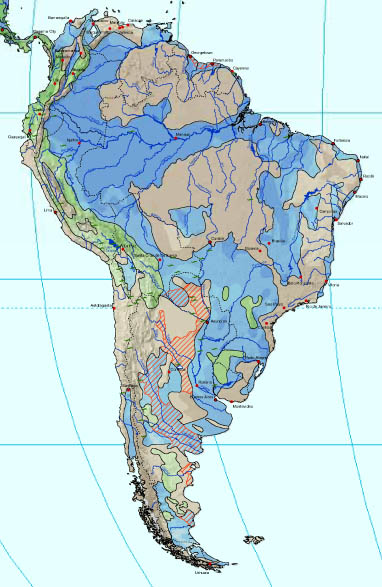The Atlas of Hidden Water
 [Image: From the "atlas of hidden water." Check out the original PDF or simply view it
[Image: From the "atlas of hidden water." Check out the original PDF or simply view it larger].
An "atlas of hidden water" has been created to reveal where the world's freshwater aquifers really lie. "The hope," New Scientist reports, "is that it will help pave the way to an international law to govern how water is shared around the world."
This prospective hydro-geopolitical legislation currently includes a "draft Convention on transboundary aquifers."
 [Image: The "hidden water" of South America].
[Image: The "hidden water" of South America]."What the UNESCO map reveals," New Scientist adds, "is just how many aquifers cross international borders. So far, the organisation has identified 273 trans-boundary aquifers: 68 in the Americas, 38 in Africa, 155 in Eastern and Western Europe and 12 in Asia." One of these is the Nubian Sandstone Aquifer System, whose waters are nearly a million years old.
According – somewhat oddly – to the International Atomic Energy Agency:
- The ancient system’s massive reserves, estimated at 375,000 cu km of water (equivalent to about 500 years of Nile River discharge), are confined deep inside the earth’s underground chambers – staggered, tiered, and pooled beneath the sands of the Sahara Desert, oasis settlements, wadis (dry riverbeds that contain water only during times of heavy rain), small villages, towns, and large cities.
A more detailed map is due out in 2009 – meanwhile, several more can be downloaded here.





Comments are moderated.
If it's not spam, it will appear here shortly!
I like the idea of an atlas of hidden water...it will shape how landscape designers plan as well...
It would be cool to be the first into an aquifer to explore it. But... aquifers are actually porous rock that contains water. Good chance you knew that and were just painting a picture, but I figured I'd clarify.
Hi,
I can't think about this without recalling the Journey to the Center of the Earth.
Now, in what state is that water ?
For what purposes we'll we be abble to use it ? And what consequences may bring to our planet and life when exploring this resource ?
This water may be important to keep a balanced temperature, for insteance.
Take care,
José
That water is held in the earth in the same way that oil is held. It is in between the pores of rocks, and it flows through interconnected paths through pore spaces. The water is, in in almost all cases, salty.
Post a Comment